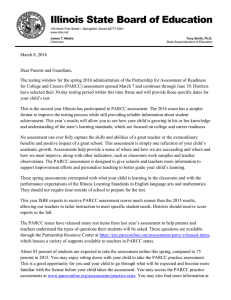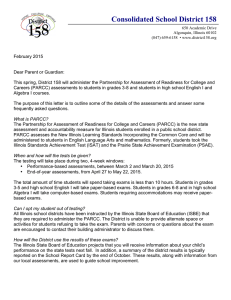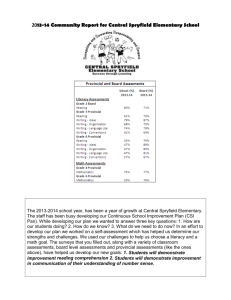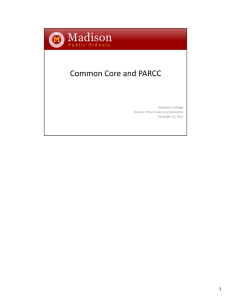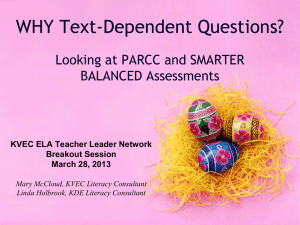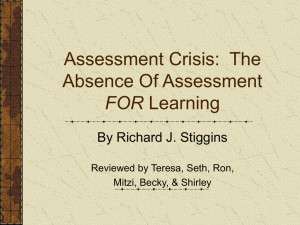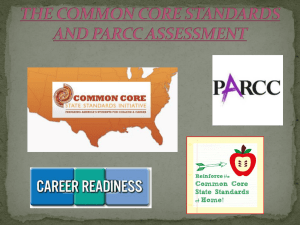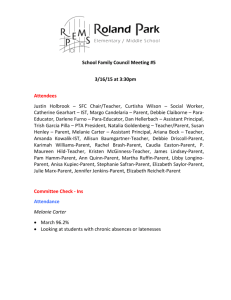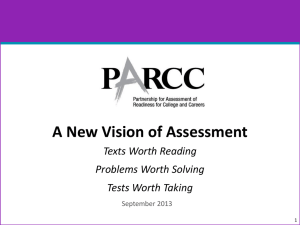Teacher Education in Illinois: A Changing World
advertisement
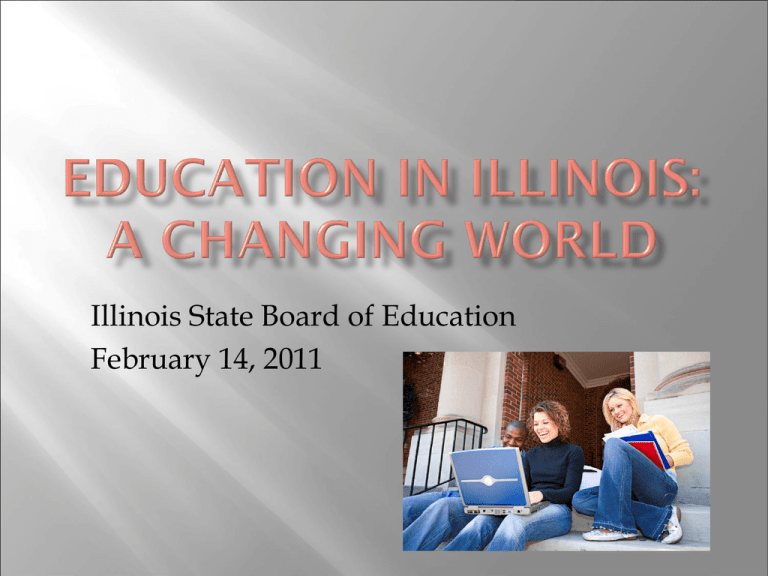
Illinois State Board of Education February 14, 2011 Pre-Service Advisory Group (PSAG) Developed Standards 23 IAC 24 Focused on “Each Child” rather than “All” Children Focused on Literacy (Elementary and Secondary) Focused on needs of Special Education, ELL/Bilingual, Gifted Combined Language Arts, Technology and Illinois Professional Teacher Standards into one set of nine standards Rules are in place and effective July 1, 2013 2 English Language Arts K-12 Cross discipline literacy expectations Reading, Writing, Listening, Speaking and Language ELA teachers and teachers in other areas are important in developing students’ literacy Integrated Model Mathematics K-12 Clarity: designed to help teachers, students, and parents understand what is expected of them to be ready to enter the workforce or college Consistency: levels the playing field so all students will be held to the same rigorous expectations Global Society: internationally benchmarked to high performing countries 4 •They demonstrate independence. •They build strong content knowledge. •They respond to varying demands of audience, task, purpose discipline. •They comprehend as well as critique. •They value evidence. •They use technology and digital media strategically and capably. •They come to understand other perspectives and cultures. 5 Benchmarked to College and Career Readiness Anchor Standards. K-8 standards are listed by grade level. 9-12 standards are listed in two year bands to allow flexibility in course design. Separated into four strands: Reading, Writing, Speaking and Listening, Language. 6 6–12 standards are divided into two sections English, Language Arts and history/social studies, science, and technical subjects. This division reflects the This division reflects: unique, time-honored place of ELA teachers in developing students’ literacy Skills and recognition that teachers in other areas must have a role in this development as well. Focus on numeracy in the early grades Basic algebraic readiness by eighth grade Geometric concepts in the middle grades Emphasis on solving real world problems No specific high school course sequence or structure recommended CCSSO content analysis of the new common core standards 8 More Meaningful Standards: consistent across states, clear to the public and on track for college. Higher Quality Tests: assessments will include performance tasks to measure critical thinking, strategic problem solving, research and writing. Through-Course Testing: Students will take parts of the assessment at key times during the school year, closer to when they learn the material. 9 9 Maximize Technology: PARCC assessments will be computer based. Cross-State Comparability: States in PARCC will adopt common assessments and common performance standards. 10 10 Oct. 2010 Launch and design phase begins Sept. 2011 Development phase begins Sept. 2012 First year field testing and related research and data collection begins Sept. 2013 Sept. 2014 Summer 2015 Second year field testing begins and related research and data collection continues Full administratio n of PARCC assessments begins Set achievement levels, including college-ready performance levels 11 11 http://www.isbe.net/common_core/ Our Students. . .Prepared for success after high school Our Promise. . .Leadership, Advocacy, & Support Our Future…Strong communities, competitive workforce 12 New, rigorous teacher and principal evaluations Independent alternative teacher and principal preparation programs Comprehensive approach to longitudinal data system Doubled the number of authorized charter schools June 1, 2010: Overhauled the State's principal preparation and certification requirements 5 time limit for certification testing requirements - February, 2010 Raised passing scores for Basic Skills test September 11, 2010 Rules for Board Review: February/March 2011 o A revamped continuous approval for higher education programs o Approval process of not-for-profits entities o New focus for principal preparation Examining different types of tasks for use as assessments during student teaching Piloting use of video for assessment activities Redefining academic language for specific content areas Working on rubrics for alignment between evidence, commentaries, and competencies Teacher and Principal Evaluation: The Performance Evaluation Advisory Council (PEAC) formed to work on a state system focused on performance and student growth. • • • • Representative teachers, administrators, researchers, and the state agency Received charge from SB 315 to develop a “Default Model” for teacher and principal evaluation, along with training program for evaluators. Meet monthly in Bloomington Building a foundation of information by learning about what is being done in the state and nationally. Provide for the use of data and indicators on student growth as a significant factor in rating the teacher’s and principal’s performance. Align with researched based standards and professional competencies Provide for an evaluator training program for every evaluator Includes evaluation of performance and student growth and based on 4 common rating system: Excellent Proficient Needs Improvement Unsatisfactory September 1, 2012 Principal Evaluation Written Plan Teacher Evaluation Written Plan Evaluators Trained Four Ratings Principals Evaluated with New Plan* SIG Grant Teachers Evaluated with New Plan 300 Schools in Chicago Evaluate Teachers September 1, 2013 Remaining CPS teachers evaluated September 1, 2014 Research-based study issued assessing validity & reliability September 1, 2015 Lowest Performing 20% of remaining school district September 1, 2016 All other school districts New Endorsement Requirements effective 2012 Impacts students in your program currently Looking at graduates coming out of programs after February 2012 Principal Preparation Legislative Changes 2014 No longer be able to recommend for General Administrative endorsement New programs must be approved and in place by 2012 or cannot admit candidates Effective February 1, 2012 24 s.h. and pass the content test for all areas except science and social science which require 32 s.h. and pass the test 12 of 24 s.h. must be upper division courses For science and social science must have 12 s.h. in a specific designation (i.e. science biology would require 12 s.h. in biology and pass test; to add physics designation would require 12 s.h. in physics and pass test). Illinois Professional Teaching Standards 2013 Graduates starting February 1, 2013 Programs must be approved by the STCB New Assessments for Professional Teaching starting 2013 Code of Ethics for Educators - Current Review dispositions to ensure aligns to Code of Ethics Talk about Code of Ethics with candidates-What does it mean to be a member of the teaching profession? Preparation Programs linked to Effective Teachers through evaluation data (2018) Must redefine how we prepare educators Must provide professional development based on performance reviews Must provide Induction and Mentoring for new teachers and principals Must understand evaluation process and ratings required-how do you evaluate in clinical Must redefine how we prepare educators Must provide professional development based on performance reviews Must provide Induction and Mentoring for new teachers and principals Must understand evaluation process and ratings required-how do you evaluate in clinical Think about the impact on PK-12 and not on candidates Focus on instruction Rules going to JCAR in March ISBE is working on template for applications All programs must be approved Defining middle level Content requirements for endorsements at middle level and elementary Moving to standards for middle level Self-contained or middle level content for overlapping grade levels Defining criteria for programs Selection Student teaching requirements Content and Standards All Stakeholders Working Together can Improve Outcomes and Opportunities for Each and Every Illinois Student. 30

